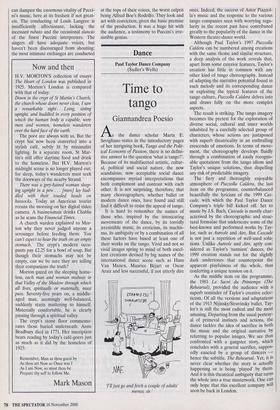Dance
Time to tango
Glannandrea Poem
Athe dance scholar Marta E. Sevigliano states in the introductory pages of her intriguing book, Tango and the Polit- ical Economy of Passion, there is no defini- tive answer to the question 'what is tango?'. Because of its multifaceted artistic, cultur- al, political and social nature, the now scandalous, now acceptable social dance encompasses myriad interpretations that both complement and contrast with each other. It is not surprising, therefore, that many choreographers, whether ballet or modern dance ones, have found and still find it difficult to resist the appeal of tango.
It is hard to remember the names of those who, inspired by the intoxicating movements of the dance, by its torridly irresistible music, its eroticism, its machis- mo, its ambiguity or by a combination of all these factors have based at least one of their works on the tango. Vivid and not so vivid images spring to mind of both excel- lent creations devised by big names of the international dance scene such as Hans Van Manen, Maurice Mart or Oscar Araiz and less successful, if not utterly dire just go and fetch a couple of adults' menus, sir.' ones. Indeed, the success of Astor Piazzol- la's music and the response to the various tango companies seen with worrying regu- larity in the recent past have contributed greatly to the popularity of the dance in the Western theatre-dance world.
Although Paul Taylor's 1997 Piazzolla Caldera can be numbered among creations with the same theme and similar structure, a deep analysis of the work reveals that, apart from some exterior features, Taylor's creation has little in common with any other kind of tango choreography. Instead of adapting the narrative potential found in each melody and its corresponding dance or exploiting the typical features of the tango culture, Piazzolla Caldera delves into and draws fully on the more complex aspects.
The result is striking. The tango imagery becomes the pretext for the exploration of diverse social, cultural and inner worlds inhabited by a carefully selected group of characters, whose actions are juxtaposed with superb theatricality in an enthralling crescendo of emotions. In terms of move- ment, the choreography develops fluidly through a combination of easily recognis- able quotations from the tango idiom and Taylor's unique solutions, thus dispelling any risk of predictable imagery.
The fiery and thoroughly enjoyable atmosphere of Piazzolla Caldera, the last item on the programme, counterbalanced beautifully the lyricism of the 1999 Cas- cade, with which the Paul Taylor Dance Company's triple bill kicked off. Set to music by J.S. Bach, Cascade is mostly char- acterised by the choreographic and struc- tural formulae that underscore some of the best-known and performed works by Tay- lor, such as Aureole and Airs. But Cascade is not just a repetition of well-used solu- tions. Unlike Aureole and Airs, aptly con- sidered as Taylor's 'sunniest' dances, the 1999 creation stands out for the slightly dark undertones that counterpoint the apparent playfulness of the whole, thus conferring a unique tension on it.
As the middle item on the programme, the 1981 Le Sacre du Printemps (The Rehearsal), provided the audience with a superb reminder of Taylor's creative eclec- ticism. Of all the versions and adaptations of the 1913 Nijinsky/Stravinsky ballet, Tay- lor's is still the most radical and the most amusing. Departing from the usual portray- al of primeval instincts and actions, the dance tackles the idea of sacrifice in both the music and the original narrative by referring to popular images. We are thus confronted with a gangster story, which concludes with a general sacrifice, suppos- edly enacted by a group of dancers hence the subtitle, The Rehearsal. Yet, it is never clear whether the story is actually happening or is being 'played' by them. And it is this theatrical ambiguity that turns the whole into a true masterwork. One can only hope that this excellent company will soon be back in London.


































































































 Previous page
Previous page